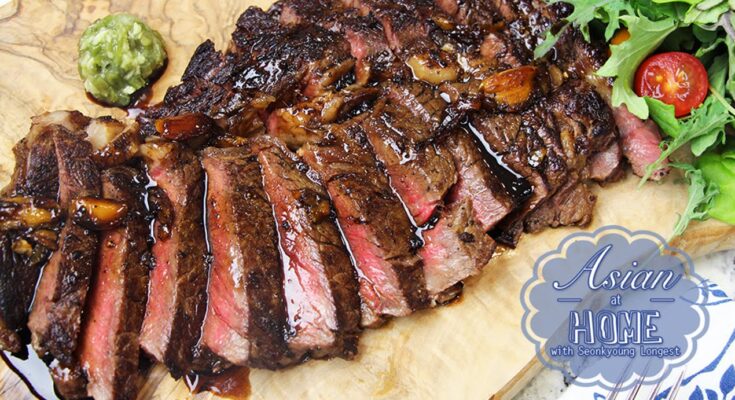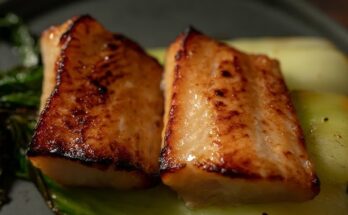New York Strip Recipe: When it comes to iconic American dishes, the New York Strip steak stands proudly among the best. It’s juicy, flavorful, and incredibly satisfying when cooked right.
Today, you’ll learn a foolproof, step-by-step method to make a restaurant-quality New York Strip at home.
Get ready to impress your taste buds — and maybe a few friends too!
What is a New York Strip Steak?
The New York Strip, also known as a strip loin or Kansas City strip, is a prized cut of beef from the short loin of the cow. It’s known for its rich flavor, tender texture, and perfect balance of fat and meat. What sets it apart is the beautiful marbling throughout the steak, which melts during cooking, creating incredible juiciness and flavor. It’s no wonder this cut is a top pick at steakhouses around the world.
Essential Ingredients You’ll Need
Before diving into the cooking process, gather the essentials:
- 1 or 2 New York Strip steaks (1.25 – 1.5 inches thick)
- Kosher salt
- Freshly ground black pepper
- Olive oil or avocado oil
- Butter
- Garlic cloves
- Fresh rosemary or thyme
High-quality ingredients make all the difference. Choose fresh herbs and real butter instead of margarine. Trust me, your steak will thank you.
Tools and Equipment Required
Cooking a New York Strip to perfection doesn’t require a ton of fancy equipment, but having the right tools can make the process easier:
- Heavy-duty skillet (cast iron preferred)
- Tongs
- Meat thermometer
- Aluminum foil
- Sharp knife
- Cutting board
Optional but useful tools include a basting spoon and a grill if you want to try outdoor cooking. Investing in a good meat thermometer ensures you hit the perfect doneness every time.
How to Choose the Perfect New York Strip
Selecting a high-quality cut is half the battle won. Here’s what to look for:
- Marbling: Fine, even streaks of fat throughout the meat.
- Color: Bright, cherry-red meat indicates freshness.
- Thickness: At least 1.25 inches thick for even cooking.
- Source: Whenever possible, go for grass-fed or dry-aged beef.
Remember, a beautiful steak starts with the meat you pick at the store or butcher. Don’t rush this step!
Preparing Your New York Strip Steak
Proper preparation is key to an incredible steak. First, remove your New York Strip from the refrigerator about 30 to 45 minutes before cooking. Why? Because starting with a room-temperature steak ensures even cooking throughout. If you cook a steak straight from the fridge, the outside may char before the inside even warms up!
Next, pat the steak dry with paper towels. Moisture on the surface can prevent the delicious sear we’re aiming for. Once dry, generously season both sides with kosher salt and freshly cracked black pepper. Don’t be shy — seasoning helps build a beautiful crust.
Some people love to marinate their steak, but with a premium cut like New York Strip, simple seasoning is best. Let the natural beefy flavor shine! However, if you want to infuse extra flavor, you can rub the steak with a little olive oil and minced garlic.
Cooking Methods for New York Strip Steak
You’ve got options when it comes to cooking your New York Strip:
- Pan-Searing: Ideal for an intense, flavorful crust.
- Grilling: Adds a smoky, charred essence.
- Reverse Searing: Best for a thick steak, giving you total control over doneness.
Each method has its perks, but if you’re new to steak cooking, pan-searing is often the easiest and most reliable. Once you get comfortable, try out different methods to find your personal favorite.
Step-by-Step Guide to Pan-Searing New York Strip
Ready to pan-sear your steak like a pro? Here’s the play-by-play:
- Preheat your pan: Place your heavy-duty skillet over high heat for a few minutes. You want it hot enough that a drop of water sizzles instantly.
- Add oil: Lightly coat the pan with a high smoke-point oil like avocado or canola oil.
- Sear the steak: Carefully lay the steak in the pan away from you to avoid splatter. Let it cook undisturbed for 3–4 minutes until a golden-brown crust forms.
- Flip and add flavor: Turn the steak, then add a couple of tablespoons of butter, a few crushed garlic cloves, and sprigs of rosemary or thyme.
- Baste the steak: Tilt the pan slightly and use a spoon to bathe the steak in the melted, herby butter.
- Check doneness: Insert a meat thermometer. Aim for:
- Rare: 120-125°F
- Medium-rare: 130-135°F
- Medium: 140-145°F
- Rest: Remove the steak and let it rest on a plate covered loosely with foil for at least 5 minutes.
Pan-searing creates an irresistible crust that locks in juices, making every bite a tender explosion of flavor.
Step-by-Step Guide to Grilling New York Strip
Prefer grilling? Here’s your simple guide:
- Preheat the grill: Get it piping hot — you’re aiming for around 450-500°F.
- Oil the grates: Use tongs and a paper towel dipped in oil to prevent sticking.
- Grill the steak: Place the steak over direct heat for about 4–5 minutes per side for medium-rare.
- Rotate halfway: If you want those fancy grill marks, rotate the steak 45 degrees halfway through cooking each side.
- Check the temperature: Use your thermometer to nail your preferred doneness.
- Rest and serve: Just like with pan-searing, rest the steak before slicing into it.
Grilling adds that signature smoky flavor that screams summer and BBQ parties. Plus, nothing beats that sizzle when a juicy steak hits a blazing grill!
How to Finish in the Oven
Thicker steaks might need a little oven time to cook evenly without burning the outside. This is where the “reverse sear” method comes in:
- Slow bake: Preheat your oven to 250°F. Place your seasoned steak on a rack over a baking sheet.
- Cook until almost done: Bake until the internal temp is about 10–15 degrees below your target doneness.
- Sear quickly: Finish the steak in a ripping hot skillet or grill for 1-2 minutes per side to get that amazing crust.
Reverse searing gives you full control over the doneness while guaranteeing that juicy, mouthwatering result every single time.
Resting the Steak: Why It’s Crucial
You might be tempted to dig right in, but patience pays off! Resting your New York Strip steak is non-negotiable if you want maximum juiciness. When steak cooks, the juices are pushed toward the surface. If you cut into it immediately, all that flavorful juice will spill out onto your plate instead of staying inside the meat.
Here’s what to do:
- After cooking, transfer the steak to a cutting board or plate.
- Loosely tent it with aluminum foil.
- Let it rest for at least 5–10 minutes.
During this time, the juices redistribute evenly throughout the steak, ensuring every bite is tender, moist, and flavorful. Think of resting as the final touch that elevates your steak from good to extraordinary.
Serving Suggestions
Now that you’ve cooked a masterpiece, it’s time to serve it like one. Here are some killer side dishes that pair perfectly with New York Strip:
- Garlic Mashed Potatoes: Creamy, buttery, and a classic steakhouse side.
- Roasted Vegetables: Carrots, asparagus, or Brussels sprouts roasted in olive oil and garlic.
- Creamed Spinach: Rich and decadent, it balances the meaty steak beautifully.
- Caesar Salad: Crisp, tangy, and refreshing.
- Buttered Corn on the Cob: Especially great if you’re grilling!
When plating, slice your steak against the grain for ultimate tenderness. Arrange slices beautifully and drizzle any leftover juices from the resting plate over the meat for an added flavor boost. Don’t forget a sprig of rosemary or a dusting of sea salt for a gourmet touch!
Common Mistakes to Avoid
Even seasoned cooks can slip up sometimes. Here are common pitfalls and how to dodge them:
- Not letting the steak reach room temperature: This leads to uneven cooking.
- Skipping the drying step: Moisture on the steak prevents the perfect sear.
- Overcrowding the pan: Always cook steaks with enough room. If you crowd the pan, you steam the meat instead of searing it.
- Overcooking: Keep a close eye on temperature. It’s better to pull it off a little early than risk a dry steak.
- Neglecting to rest: Trust me, it’s worth the few minutes wait.
Avoiding these mistakes will help you consistently deliver steakhouse-quality results at home.
Expert Tips for the Perfect New York Strip
Want to take your steak to the next level? Here are some expert secrets:
- Butter Baste: Continuously spoon melted butter and herbs over the steak for luxurious flavor and a glossy finish.
- Use a Thermometer: Guesswork leads to disappointment. A thermometer guarantees perfection.
- Season Early: Salt your steak 40 minutes to an hour before cooking if possible. It acts like a dry brine, intensifying flavor and tenderness.
- Rest Twice: After cooking and before slicing for the ultimate experience.
- Invest in Quality Meat: Prime or Choice grade beef yields the best texture and taste.
Following these tips can make the difference between a good steak and an unforgettable one.
FAQs about New York Strip Recipe
What is a New York Strip steak?
A New York Strip is a premium cut of beef taken from the short loin of a cow. It’s known for its tenderness, bold flavor, and perfect marbling, making it a top choice for steak lovers.
How do I choose the best New York Strip steak?
Look for steaks that are bright red with even marbling throughout. A thicker cut (at least 1 inch) is best for even cooking and a juicy, flavorful bite.
Should I marinate a New York Strip steak?
While you can marinate it, it’s not necessary. The natural flavor of a good New York Strip is best enhanced with simple seasonings like salt, pepper, garlic, and butter.
What’s the best way to cook a New York Strip steak?
Searing the steak in a hot cast-iron skillet or grilling it over high heat are two of the best methods. Finish it with a pat of butter for extra richness.
What temperature should a New York Strip steak be cooked to?
For a medium-rare steak, cook it to an internal temperature of 130–135°F (54–57°C). Always use a meat thermometer for the most accurate results.
Do I need to let the steak rest after cooking?
Yes! Let the steak rest for about 5–10 minutes after cooking. This helps the juices redistribute, keeping the meat tender and juicy.
Can I cook a New York Strip in the oven?
Absolutely! After searing the steak on the stove, you can transfer it to a preheated oven at 400°F (200°C) to finish cooking to your desired doneness.
What are good sides for New York Strip steak?
Popular sides include mashed potatoes, roasted vegetables, garlic butter mushrooms, or a fresh garden salad.
Can I freeze a cooked New York Strip steak?
Yes, you can freeze it. Wrap it tightly in foil or a freezer bag and store it for up to 2–3 months. Thaw in the fridge before reheating gently.
How do I reheat a New York Strip steak without drying it out?
The best method is to reheat it slowly in a low-temperature oven (around 250°F) and then give it a quick sear in a hot pan to restore the crust.
Conclusion
Cooking the perfect New York Strip steak isn’t just about following a recipe—it’s about understanding the little details that elevate the final dish. From choosing a marbled cut to letting the steak rest after cooking, every step matters. With a bit of practice (and maybe a few delicious test runs), you’ll be able to master this classic steak and impress everyone lucky enough to snag a seat at your table.
Now, grab that apron, fire up the skillet or grill, and bring a little bit of steakhouse magic into your own kitchen tonight. You’ve got this!



